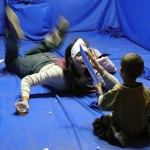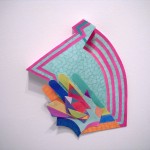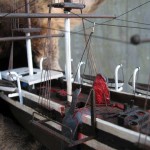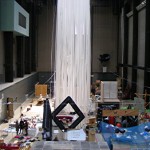Mia Feuer’s two powerful installations at FLUX space (March 14 – April 5, 2009) are products of the post-9/11 world. They spoke of control, isolation, surveillance, and the collapse of everything we thought most solid and secure.
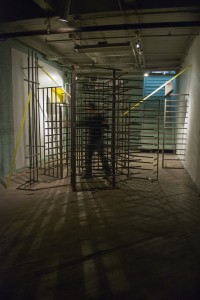
The exhibition by the Virginia sculptor curated by Angela Jerardi (new to Philadelphia and someone to watch) was situated in two discrete rooms. The street door led to the steel structure of Turnstile (2008), which was welded in place and occupied most of the downstairs gallery. Its steel bars cast cage-like shadows on the floor in front of the subway-style turnstiles, allowing visitors to enter and exit its labyrinthine spaces. These were flanked by two structures suggesting observation towers, topped with speaker-like forms. The fact that one was painted yellow, as were three angled struts, did little to relieve the sense that this was an environment of regulation and restraint.
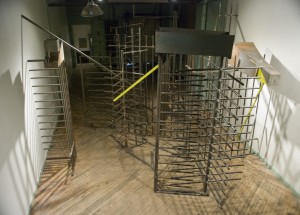
I had the gallery to myself and the combination of prison-like spaces and sharp shadows in the window-less room evoked an expressionist stage set. It’s possible that the environment would read differently if filled with crowds, but Jerardi’s gallery notes suggested that the work was inspired by the artist’s experience of traversing the Israel/Palestine border, so the darker reading was certainly intended.
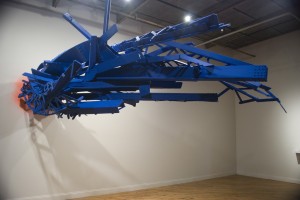
Up a flight of steps the intense, cobalt-blue structure of Collapse (2009) cantilevered off a wall some six feet off the floor. The wall was stained a day-glo orange where the jumble of beams met it. The piece looked like the detritus of a collapsed bridge: the beams were studded with grommets and the cross-bracing had become un-hinged. It was almost animate, like the claw of a huge robot which had violently broken through the wall.
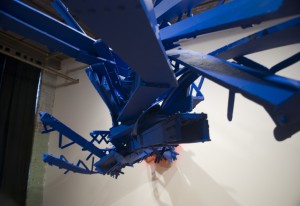
The forms become even more chaotic as one circled around it. It was inspired by the Arlington Bridge in Winnipeg, whose origins are shrouded in possibly-fictional urban legend. But it’s splintered and falling forms evoked both the bridge over the Mississippi in Minneapolis which collapsed in 2007 as well as the twisted wreckage of the World Trade Center. Feuer’s work is a disturbingly appropriate reflection of a world riddled by violence and regulated by fear.



